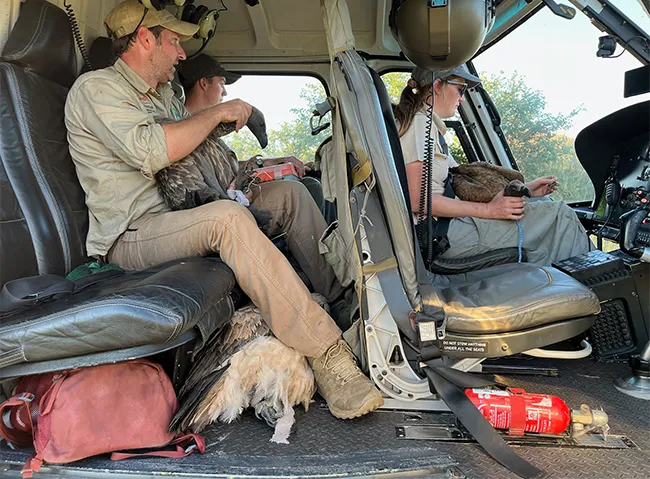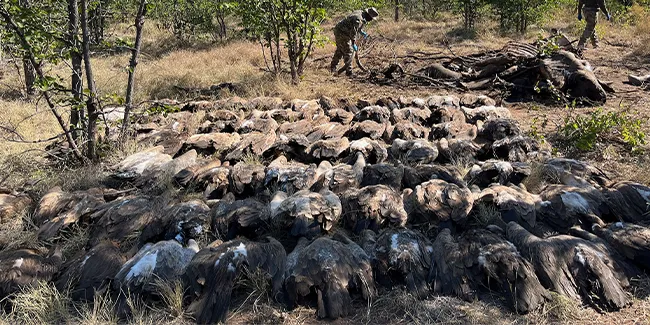Mass vulture poisoning in Kruger National Park: a conservation crisis

Eighty-four vultures have been rescued by a joint team of SANParks rangers and Endangered Wildlife Trust (EWT) officials from a devastating poisoning in the Kruger National Park.
Image: Endangered Wildlife Trust
More than 100 vultures have died in a mass poisoning at the Kruger National Park - one of the largest vulture poisoning events in Southern Africa.
The incident in the Mahlangeni Section of the Park was detected by the Endangered Wildlife Trust’s (EWT) wildlife poisoning surveillance and detection system which triggered an alert, flagging suspicious activity in a remote section of the park.
Within hours, a joint SANParks and EWT team mobilised, arriving on site. There, they discovered the grim reality: a mass poisoning event involving hundreds of vultures. This was the result of an elephant carcass laced with highly toxic agrochemical pesticides - poison laid by poachers to harvest body parts for the illegal wildlife trade.

A total of 116 vultures were found dead at the scene.
Image: EWT
A total of 116 vultures were found dead at the scene.
“The initial responders - six SANParks rangers and two EWT officials - found two vultures alive, but severely affected, roughly 500 metres from the poisoned elephant carcass. These were immediately treated using emergency vulture first aid: atropine, activated charcoal, and fluid therapy,” SANParks and EWT said in a statement on Thursday.
Reinforcements were swiftly deployed. Support teams from the Moholoholo Wildlife Rehabilitation Centre, Briner Veterinary Services and Wildscapes Veterinary Services mobilised within hours, while SANParks activated ranger and aerial support including the Hope for Wildlife helicopter and additional logistics support, making this the first time SANParks helicopters were formally used in a wildlife poisoning rescue of this scale.
In a coordinated, high-intensity rescue effort, 84 vultures including White-backed, Cape, and Hooded Vultures were rescued alive. Forty-five were transported by their vulture ambulance, a specialised mobile unit designed to stabilise poisoned birds en route to treatment facilities. Thirty-nine more were airlifted by helicopter to the SANParks K9 facility in Phalaborwa for immediate monitoring.
A final group was transported later that night to Moholoholo for continued intensive care.
“Teams include vets from WildScapes and Briner Veterinary Services, as well as the Moholoholo team, worked through the night to stabilize each bird and keep them alive.”
Despite the best efforts, five vultures succumbed to poisoning.
As of Thursday morning, 83 vultures were alive and recovering.
“The scale of the tragedy is staggering: 123 vultures were found dead at the scene - 102 White-backed Vultures, 20 Cape Vultures, and one Lappet-faced Vulture, all listed as endangered or critically endangered species. Of these, 116 were already deceased when the team arrived,” SANParks and EWT said.
“This marks one of the largest vulture poisoning events in Southern Africa - and the most extensive coordinated response effort and rescues to date. Over 20 individuals across conservation, veterinary, and enforcement sectors played a role in the rescue and response.”
The horrific incident is part of a broader crisis unfolding across southern Africa with the escalating use of poisons in wildlife poaching. Poachers increasingly use agricultural toxins to target high-value species, not just vultures, but also lions, whose body parts are in growing demand for traditional medicine.
“This incident is a setback to the vulture population in the Greater Kruger Landscape which is trying to recover from similar incidents in the past.
“SANParks is collaborating with various agencies and institutions to address the current increase, in particular poisoning incidents. The latest operation highlights the importance of partnerships in addressing this problem. The recovery and treatment of the live vultures would not have been possible if such partnerships were not in place.”
Cape Times
Related Topics: